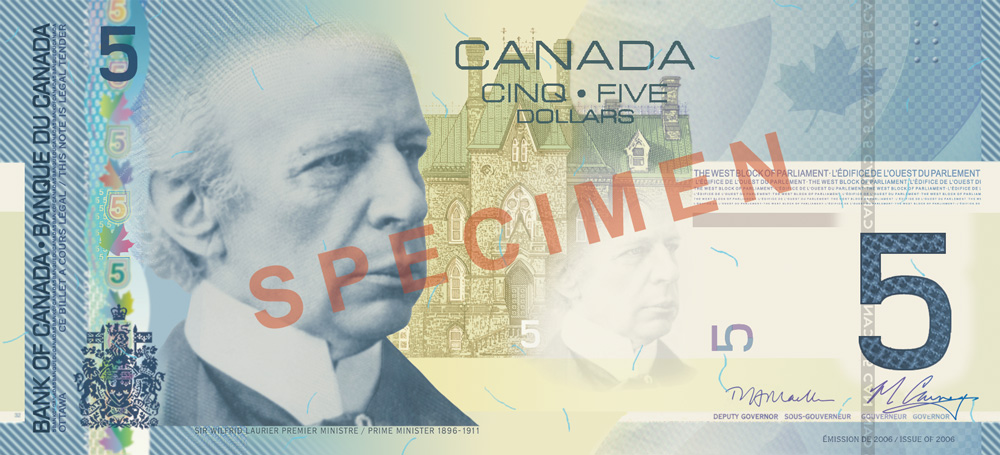This series incorporated security features never before seen in Canadian bank notes.
Canadian Journey series (2001–2006)
Canadian Journey notes were distinguished not only by enhanced security features, but also by world-class designs and the introduction of a tactile feature to help the blind and partially sighted to identify the different denominations.
Security
How to check notes
Checking security features on bank notes is simple to do. But if you have doubts when verifying any note, ask for another one.
Canadian Journey notes (2004–2006)
The Canadian Journey $20, $50 and $100 notes were introduced in 2004, and the $5 and $10 notes were upgraded in 2005–2006 so that the same suite of security features appears on all five denominations.
1. Metallic stripe
Tilt the note. The numbers and maple leaves change colour.
2. Ghost image
Hold the note up to the light and look through it. A small, ghost-like image of the portrait appears. It is visible from both sides of the note.
3. Dashes
Hold the note up to the light and look through it. The dashes form a solid line. It is visible from both sides of the note.
Tilt the note. The dashes shift from gold to green. Small characters (e.g., CAN 20) match the note’s value.
4. Puzzle number
Hold the note up to the light and look through it. Irregular marks on the front and back of the note form a complete number. It is visible from both sides of the note.
5. Raised ink
Feel the raised ink on the shoulders of the portrait, the large number, and the words “Bank of Canada • Banque du Canada.”
6. UV feature
Look at the note under UV (ultraviolet) light. Check that the text BANK OF CANADA – BANQUE DU CANADA and a number matching the note’s value glow in interlocking red and yellow. Red and yellow fibres are scattered on both sides of the note.
Tip: Don’t rely solely on this feature. Always look at two or more features when checking notes.
Original Canadian Journey $5 and $10 notes (2001–2002)
The original $5 and $10 notes of the Canadian Journey series (2001-2002) had different security features that did not include a metallic stripe, ghost image, dashes, or a puzzle number.
1. Maple leaves
Tilt the note. Three maple leaves shift from pale to shiny gold.
2. Hidden number
Slightly tilt the note at eye level. The number 5 or 10 appears.
3. Raised ink
Feel the raised ink on the shoulders of the portrait, the large number 5 or 10, and the words “Bank of Canada • Banque du Canada.”
4. UV feature
Look at the note under UV (ultraviolet) light. The coat of arms and the words FIVE ● CINQ (or DIX ● TEN) and BANK OF CANADA – BANQUE DU CANADA glow in blue over the portrait. Red fibres are scattered on both sides of the note.
Tip: Don’t rely solely on this feature. Always look at two or more features when checking notes.
Design
What’s on the Canadian Journey series notes?
The Canadian Journey series celebrates our culture, history and achievements. Read about the design features of each note.
Canadian Journey series – Upgraded $5 note
Upgraded $5 note - Design features
- Portrait: Sir Wilfrid Laurier, Prime Minister, 1896–1911
- Signatures: Left – W.P. Jenkins, Right – D.A. Dodge / Left – W.P. Jenkins, Right – M.J. Carney
- Size: 152.4 x 69.85 mm (6.0 x 2.75 inches)
- Issue Date: 15 November 2006
- Theme: Children at Play
Young Canadians are the future of our nation, and play is a healthy part of their physical, social, and cultural development. Images of youngsters having fun tobogganing, learning to skate, and playing ice hockey capture the spirit and beauty of the Canadian winter. Against a backdrop of snowflakes, excerpts from Roch Carrier’s book, Le Chandail de hockey,* and its English adaptation by Sheila Fischman, The Hockey Sweater, evoke memories of childhood.
*Le Chandail de hockey was published by Éditions Alain Stanké; the English adaptation was published by House of Anansi Press.
Note: The original $5 note was issued on 27 March 2002. The signature possibilities are as follows: Left – M.D. Knight, Right – D.A. Dodge / Left – W.P. Jenkins, Right – D.A. Dodge.
Canadian Journey series – Upgraded $10 note
Upgraded $10 note - Design features
- Portrait: Sir John A. Macdonald, Prime Minister, 1867–1873 and 1878–1891
- Signatures: Left – W.P. Jenkins, Right – D.A. Dodge / Left – W.P. Jenkins, Right – M.J. Carney
- Size: 152.4 x 69.85 mm (6.0 x 2.75 inches)
- Issue Date: 18 May 2005
- Theme: Remembrance and Peacekeeping
A veteran and two young people observe a Remembrance Day service as members of the Land and Naval Forces stand vigil. A member of the Armed Forces in a peacekeeping role complements the scene. Featured on the back of the note are the first verse of John McCrae’s poem, In Flanders Fields, and its French adaptation, Au champ d’honneur, by Jean Pariseau, together with doves and a wreath of poppies, which symbolize peace and commemoration.
Note: The original $10 note was issued on 17 January 2001. The signature possibilities are as follows: Left – M.D. Knight, Right – G.G. Thiessen / Left – M.D. Knight, Right – D.A. Dodge / Left – W.P. Jenkins, Right – D.A. Dodge.
Canadian Journey series – $20 note
$20 note - Design features
- Portrait: Her Majesty Queen Elizabeth II
- Signatures: Left – W.P. Jenkins, Right – D.A. Dodge / Left – W.P. Jenkins, Right – M.J. Carney
- Size: 152.4 x 69.85 mm (6.0 x 2.75 inches)
- Issue Date: 29 September 2004
- Theme: Arts and Culture
Our nation’s visual, literary and performing arts enrich the lives of all Canadians. The artwork of Bill Reid, inspired by the Haida culture of the northwest coast, was chosen to illustrate this theme. The $20 note also features an excerpt* from La montagne secrète, a novel by renowned Canadian author Gabrielle Roy, published in 1961, and the English translation by Harry L. Binsse, The Hidden Mountain, published in 1962. The quotation reminds us that arts and culture define who we are, as well as the system of beliefs, values and customs that we share.
* Used by permission, McClelland & Stewart Ltd. The Canadian Publishers.
Canadian Journey series – $50 note
$50 note - Design features
- Portrait: William Lyon Mackenzie King, Prime Minister, 1921–1930 and 1935–1948
- Signatures: Left – W.P. Jenkins, Right – D.A. Dodge / Left – W.P. Jenkins, Right – M.J. Carney
- Size: 152.4 x 69.85 mm (6.0 x 2.75 inches)
- Issue Date: 17 November 2004
- Theme: Nation Building—Shaping the Political, Legal and Social Structures for Democracy and Equality
This note celebrates Canadians who have campaigned for the rights and freedoms that every citizen of Canada now enjoys. The Thérèse Casgrain Volunteer Award commemorates Thérèse Casgrain’s lifelong campaign for social justice and equality and recognizes volunteers for their pioneering spirit and commitment to helping others. The statue of the Famous Five—Emily Murphy, Nellie McClung, Irene Parlby, Henrietta Muir Edwards and Louise McKinney—celebrates their victory in the “Persons” Case. On 18 October 1929, the British Privy Council declared that women are persons, thus making them eligible to be appointed to the Senate of Canada. The featured quotation is from the Universal Declaration of Human Rights, first drafted by Canadian John Peters Humphrey.
Canadian Journey series – $100 note
$100 note - Design features
- Portrait: Sir Robert Borden, Prime Minister, 1911–1920
- Signatures: Left – W.P. Jenkins, Right – D.A. Dodge / Left – W.P. Jenkins, Right – M.J. Carney
- Size: 152.4 x 69.85 mm (6.0 x 2.75 inches)
- Issue Date: 17 March 2004
- Theme: Exploration and Innovation
The themes of exploration and innovation are illustrated with images of Canadian achievements in cartography and communications. A map of Canada created by Samuel de Champlain in 1632* is paired with a birchbark canoe and juxtaposed with depictions of a satellite image of the country, Radarsat-1, and a telecommunications antenna. An excerpt from Miriam Waddington’s poem, Jacques Cartier in Toronto, and its French translation by Christine Klein-Lataud, summarizes humanity’s eternal quest for discovery.
*Courtesy of Library and Archives Canada.













